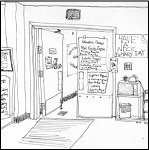Recording information about observations

By Herb Katz
Reprinted from Norton, 1996, p. 3
Approaches to recording information range from informal/unstructured to
formal/structured methods. Formal methods use a structure, developed
observe. Informal documentation is relatively unstructured and includes
participants' permission, you might also take photographs or make sketches or
diagrams to record what you observe.
Notes serve as a record of what you attended to during your observation.
They can help guide further observation and other data collection
methods. What you write down becomes your data.
Following are some suggestions for taking and writing up notes (Robson,
1993, p. 203):
- It is important to have a system that allows you to record information
as clearly, regularly and fully as possible.
- When possible, record observations during the event. These can be
condensed and will serve as reminders of what happened when you
write up detailed notes. You might note important verbatim comments,
or inconsistencies that you want to explore. When it is not possible to
make notes during the event, try to do so as soon as you can afterwards.
- Go through your notes as soon as possible to add detail and ensure that
you understand the record and that it includes what you want to say.
- Some researchers find it helpful to make large margins on one side of
their notebooks. They write observations on the main part, and include
their comments, reflections, etc. in the margins. If you enter your notes
on a word processor, you might use a different font or style to identify
your reflections.
- Try to write up your notes as soon as you can after your observation,
and before you start a second observation.
Following are ideas about what to include in your write-up (Merriam, 1988).
- A description of the event and activities
- Quotations or paraphrases of what people said
- Your comments, including interpretative ideas or analysis, personal
feelings and impressions
- Reminders about additional information you want to watch for

